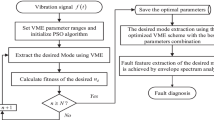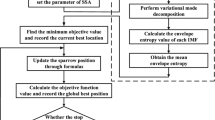Abstract
Rolling bearing failure is widely regarded as a failure form of industrial machines. Owing to the poor operating circumstance with the stochastic contact between rolling elements, the performance of the bearing will deteriorate over time and cause a cascade breakdown in the mechanical system. Early fault detection has been found to be an effective strategy to avoid economic loss. Therefore, an integration method for fault diagnosis that combines backtracking strategy, improved variational mode decomposition (VMD), and infogram is proposed to tackle the challenge of the early feature extraction from the heavy noisy non-stationary signal. The backtracking strategy is adopted to track the data sample points earlier than the fault threshold determined based on the kurtosis index. The optimum parameters α and K of VMD are acquired through the particle swarm optimization (PSO) algorithm. In this way, the more accurate intrinsic mode functions (IMFs) can be gained by the improved VMD. The optimum IMFs are acquired according to the maximum values of kurtosis and correlation coefficients, and these IMFs can be reconstructed into the noise reduction signal. Since envelope analysis requires the selection of the appropriate central frequency and bandwidth, infogram is utilized to select the values of them. A simulated case is applied to demonstrate the validation of the proposed method. And to further illustrate its practicality, it is employed to perform early fault diagnosis for an experimental case. According to the diagnosis results, the proposed method has conspicuous superiority over the other existing technologies for estimating incipient fault time of the bearing.
Similar content being viewed by others
References
B. P. Graney and K. Starry, Rolling element bearing analysis, Materials Evaluation, 70 (2012) 78–85.
H. O. Omoregbee and P. S. Heyns, Fault detection in roller bearing operating at low speed and varying loads using Bayesian robust new hidden Markov model, Journal of Mechanical Science and Technology, 32 (2018) 4025–4036.
D. Zhu, Y. Zhang, S. Liu and Q. Zhu, Adaptive combined HOEO based fault feature extraction method for rolling element bearing under variable speed condition, Journal of Mechanical Science and Technology, 32 (2018) 4589–4599.
Y. Li, X. Liang, M. Xu and W. Huang, Early fault feature extraction of rolling bearing based on ICD and tunable Q-factor wavelet transform, Mechanical Systems and Signal Processing, 86 (2017) 204–223.
Y. Hong, M. Kim, H. Lee, J. J. Park and D. Lee, Early fault diagnosis and classification of ball bearing using enhanced kurtogram and Gaussian mixture model, IEEE Transactions on Instrumentation and Measurement, 68(12) (2019) 4746–4755.
Y. K. Gu, X. Q. Zhou, D. P. Yu and Y. J. Shen, Fault diagnosis method of rolling bearing using principal component analysis and support vector machine, Journal of Mechanical Science and Technology, 32 (2018) 5079–5088.
Z. Y. He, G. Chen, T. F. Hao, C. Y. Teng, M. L. Hou and Z. J. Cheng, Weak fault detection method of rolling bearing based on testing signal far away from fault source, Journal of Mechanical Science and Technology, 34 (2020) 1035–1048.
Y. Lei, N. Li, L. Guo, N. Li, T. Yan and J. Lin, Machinery health prognostics: a systematic review from data acquisition to RUL prediction, Mechanical Systems and Signal Processing, 104 (2018) 799–834.
Y. Li, M. Xu, Y. Wei and W. Huang, Health condition monitoring and early fault diagnosis of bearings using SDF and intrinsic characteristic-scale decomposition, IEEE Transactions on Instrumentation and Measurement, 65(9) (2016) 2174–2189.
H. Cao, L. Niu, S. Xi and X. Chen, Mechanical model development of rolling bearing-rotor systems: a review, Mechanical Systems and Signal Processing, 102(1) (2018) 37–58.
C. S. Park, Y. C. Choi and Y. H. Kim, Early fault detection in automotive ball bearings using the minimum variance cepstrum, Mechanical Systems and Signal Processing, 38(2) (2013) 534–548.
L. Cui, C. Kang, Y. Xu and X. Gao, Integrated algorithm research on early impactive fault feature extraction of rolling bearings, Chinese Journal of Scientific Instrument, 31(11) (2010) 2422–2427 (in Chinese).
Y. Lei, L. Jing and J. Zheng, A review on empirical mode decomposition in fault diagnosis of rotating machinery, Mechanical Systems and Signal Processing, 35(1–2) (2013) 108–126.
N. E. Huang, Z. Shen, S. R. Long, M. C. Wu, H. H. Shih, Q. Zheng, N. C. Yen, C. C. Tung and H. H. Liu, The empirical mode decomposition and the Hilbert spectrum for nonlinear and non-stationary time series analysis, Proceedings of the Royal Society of London A: Mathematical, Physical and Engineering Sciences, 454(1971) (1998) 903–995.
H. Wang, J. Chen and G. Dong, Feature extraction of rolling bearing’s early weak fault based on EEMD and tunable Q-factor wavelet transform, Mechanical Systems and Signal Processing, 48(1–2) (2014) 103–119.
A. Tabrizi, L. Garibaldi, A. Fasana and S. Marchesiello, Early damage detection of roller bearings using wavelet packet decomposition, ensemble empirical mode decomposition and support vector machine, Meccanica, 50(3) (2015) 865–874.
Y. Lv, R. Yuan and G. Song, Multivariate empirical mode decomposition and its application to fault diagnosis of rolling bearing, Mechanical Systems and Signal Processing, 81(15) (2016) 219–234.
X. An, H. Zeng and W. Yang, Fault diagnosis of a wind turbine rolling bearing using adaptive local iterative filtering and singular value decomposition, Transactions of the Institute of Measurement and Control, 39(11) (2017) 1643–1648.
K. Dragomiretskiy and D. Zosso, Variational mode decomposition, IEEE Transactions on Signal Processing, 62(3) (2014) 531–544.
P. S. Kumar, L. A. Kumaraswamidhas and S. K Laha, Selecting effective intrinsic mode functions of empirical mode decomposition and variational mode decomposition using dynamic time warping algorithm for rolling element bearing fault diagnosis, Transactions of the Institute of Measurement and Control, 41(7) (2018) 1923–1932.
J. Antoni, The spectral kurtosis: a useful tool for characterizing non-stationary signals, Mechanical Systems and Signal Processing, 20(2) (2006) 282–307.
J. Antoni, Fast computation of the kurtogram for the detection of transient faults, Mechanical Systems and Signal Processing, 21(1) (2007) 108–124.
Y. Lei, J. Lin, Z. He and Y. Zi, Application of an improved kurtogram method for fault diagnosis of rolling element bearings, Mechanical Systems and Signal Processing, 25(5) (2011) 1738–1749.
T. Barszcz and A. Jablonski, A novel method for the optimal band selection for vibration signal demodulation and comparison with the kurtogram, Mechanical Systems and Signal Processing, 25(1) (2011) 431–451.
J. Antoni, The infogram: entropic evidence of the signature of repetitive transients, Mechanical Systems and Signal Processing, 74(1) (2016) 73–94.
D. Wang, An extension of the infogram to novel Bayesian inference for bearing fault feature identification, Mechanical Systems and Signal Processing, 80(1) (2016) 19–30.
D. Wang and K. L. Tsui, Dynamic Bayesian wavelet transform new methodology for extraction of repetitive transients, Mechanical Systems and Signal Processing, 88(1) (2017) 137–144.
C. Yi, Y. Lv and Z. Dang, A fault diagnosis scheme for rolling bearing based on particle swarm optimization in variational mode decomposition, Shock and Vibration (2016).
S. T. Wan, X. Zhang and L. J. Dou, Compound fault diagnosis of bearings using improved fast spectral kurtosis with VMD, Journal of Mechanical Science and Technology, 32 (2018) 5189–5199.
H. Xu and G. Chen, An intelligent fault identification method of rolling bearings based on LSSVM optimized by improved PSO, Mechanical Systems and Signal Processing, 35(1–2) (2013) 167–175.
M. Zhang, Z. Jiang and K. Feng, Research on variational mode decomposition in rolling bearings fault diagnosis of the multistage centrifugal pump, Mechanical Systems and Signal Processing, 93(1) (2017) 460–493.
Y. Yang, W. Yang and D. Jiang, Simulation and experimental analysis of rolling element bearing fault in rotor-bearing-casing system, Engineering Failure Analysis, 92 (2018) 205–221.
M. Yuwono, Y. Qin, J. Zhou, Y. Guo, B. G. Celler and S. W. Su, Automatic bearing fault diagnosis using particle swarm clustering and hidden markov model, Engineering Applications of Artificial Intelligence, 47 (2016) 88–100.
G. J. Tang and X. L. Wang, Paramter optimized variational mode decomposition method with application to incipient fault diagnosis of rolling bearing, Journal of Xi’an Jiaotong Uinversity, 49(5) (2015) 73–81.
I. Howard, A Review of Rolling Element Bearing Vibration Detection, Diagnosis and Prognosis, Aeronautical and Maritime Research Laboratory, Defense Science and Technology Organization (DESTO), Melbourne, Australia (1994).
P. Borghesani, R. Ricci, S. Chatterton and P. Pennacchi, A new procedure for using envelope analysis for rolling element bearing diagnostics in variable operating conditions, Mechanical Systems and Signal Processing, 38(1) (2013) 23–35.
R. B. Randall and J. Antoni, Rolling element bearing diagnostics-a tutorial, Mechanical Systems and Signal Processing, 25(2) (2011) 485–520.
J. S. Smith, The local mean decomposition and its application to EEG perception data, Journal of the Royal Society Interface, 2(5) (2005) 443–454.
J. Gilles, Empirical wavelet transform, IEEE Transactions on Signal Processing, 61(16) (2013) 3999–4010.
S. N. Chegini, M. J. H. Manjili and A. Bagheri, New fault diagnosis approaches for detecting the bearing slight degradation, Meccanica, 55(1) (2020) 261–286.
F. Jiang, Z. Zhu and W. Li, An improved VMD with empirical mode decomposition and its application in incipient fault detection of rolling bearing, IEEE Access, 6 (2018) 44483–44493.
J. Ma, J. Wu and X. Wang, Incipient fault feature extraction of rolling bearings based on the MVMD and teager energy operator, ISA Transactions, 80 (2018) 297–311.
Acknowledgments
This work is supported by the program of the National Natural Science Foundation of China (grant number 51765034), and the Hongliu First-class Disciplines Development Program of Lanzhou University of Technology.
Author information
Authors and Affiliations
Corresponding author
Additional information
Abdalla Babiker Abdalla is currently an M.S. candidate in School of Mechanical & Electronical Engineering at Lanzhou University of Technology-China. He received his B.S. in School of Mechanical Engineering-Sinnar University-Sudan, 2012. His research interests include reliability engineering and fault diagnosis.
Changfeng Yan is currently a Professor in School of Mechanical & Electronical Engineering at Lanzhou University of Technology. He received his B.S. from Huazhong University of Science & Technology in 1996, M.S. from Shenyang University of Technology in 2002 and Ph.D. from Tongji University in 2010. His research interests include fault diagnosis and signal process.
Qiang Li is currently an M.S. candidate in School of Mechanical and Electrical Engineering at Lanzhou University of Technology. He received his B.S. in School of Mechanical and Electrical Engineering from Lanzhou University of Technology in 2017. His research interests include prognostics and health management, condition monitoring and fault diagnosis.
Rights and permissions
About this article
Cite this article
Babiker, A., Yan, C., Li, Q. et al. Initial fault time estimation of rolling element bearing by backtracking strategy, improved VMD and infogram. J Mech Sci Technol 35, 425–437 (2021). https://doi.org/10.1007/s12206-021-0101-7
Received:
Revised:
Accepted:
Published:
Issue Date:
DOI: https://doi.org/10.1007/s12206-021-0101-7




